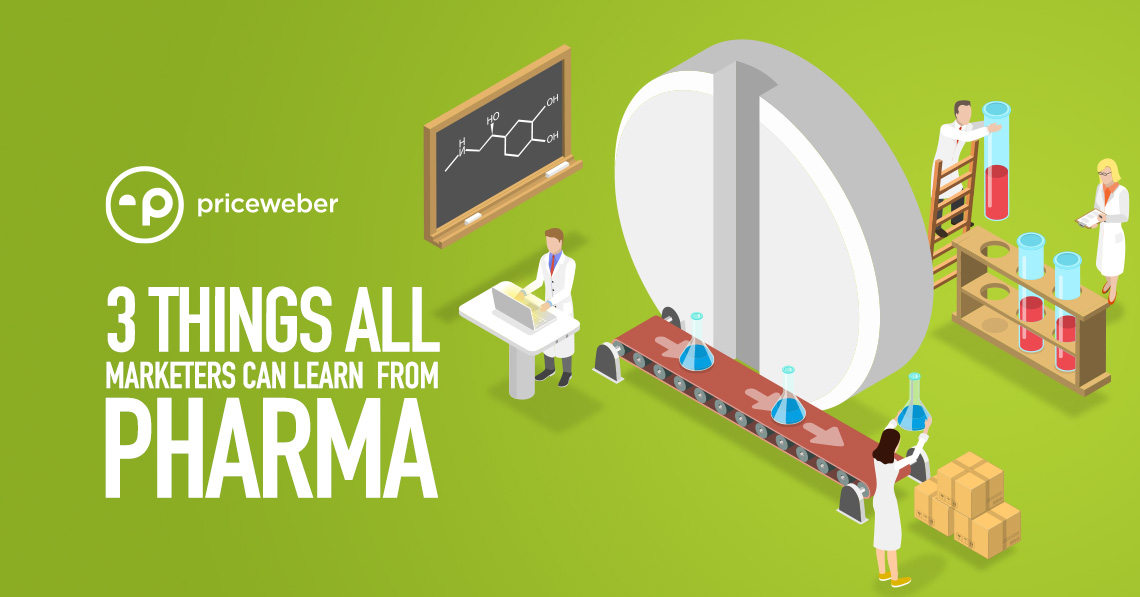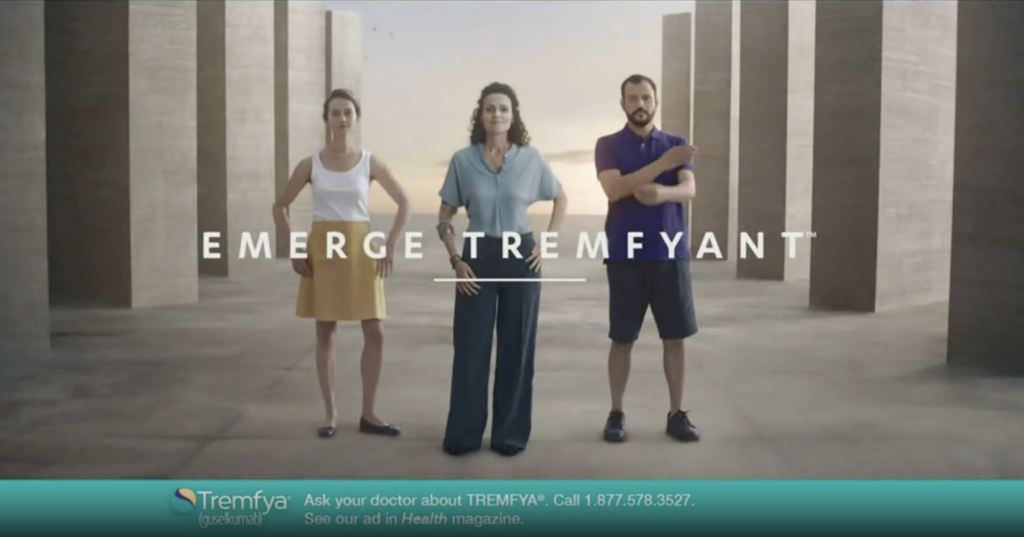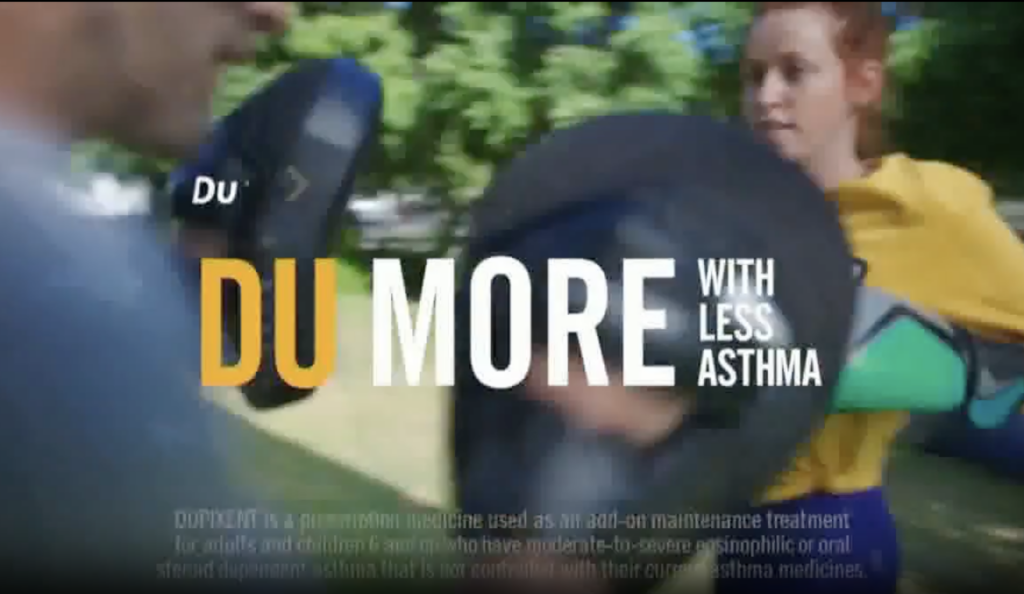We’ve all seen them – 60-second commercials that pop up during our favorite TV shows where everyone seems to be dancing, mountain biking or kayaking to happy music while the list of potential side-effects is described in the background. With revenues exceeding $600B, it is not surprising that pharmaceutical companies shelled out almost $8.1 billion last year on paid advertising, according to Endpoints News. Seventy percent of that was spent on linear TV.
The top 10 pharma ad brands alone contributed to a combined total of $1.68 billion in ad spend. But are they necessary? Do they work? In this edition of Plain Talk, we’ll address those two questions and what the rest of us marketers can learn from TV advertising’s fourth largest industry – Pharma.
Topics covered:
- Pull marketing works – target the end consumer regardless of the channel
- Addressing side effects head-on will not necessarily affect demand if handled in context
- Selling empowerment works
Pull marketing works – target the end consumer regardless of the channel
When the FDA decided to permit drug ads on television in 1985, it redefined how medications were to be marketed. The long and short of why the industry markets directly to consumers is because it works. In an article from the Journal of the American Medical Association from August 12, 2022, results from pharma TV advertising research concluded, “Participants in the treatment groups were more likely to report favorable perceptions of pharmaceutical manufacturers and medication-related behavior intentions, such as switching medications.”
With billions spent on television exposure and the audience’s access to information via the internet, people have felt empowered more than ever before to research and understand complicated medical conditions and potential treatments like the medications shown on TV. In 2020, the average American spent 156 hours scouring the internet to better understand their own health. That’s almost the equivalent of four work weeks.
But it’s not just healthcare they’re researching. According to Cox Automotive, in 2022, the average car buyer spent 14 hours and 39 minutes researching, shopping and purchasing their next vehicle, up 18% from 2021!
As for general purchases, 99% of shoppers research purchases online before going to a store. So, if the consumer is going to spend time researching, it’s important that advertisers provide all benefits to products as early in the buying cycle as possible.
Addressing side effects head-on will not necessarily affect demand if handled in context
In reviewing dozens of pharma ads, it’s clear they all preach, “Empowering you (the end-consumer) to live your best life!” Further, they all follow the same formula, usually in full 60-second spots:
1. Identify the problem.
2. Provide a solution and its benefits.
3. Verbally address any side effects while maintaining a happy, healthy lifestyle and continue to depict the benefits of the advertised solution.
4. Close with a strong statement of personal empowerment.
In providing the solution and benefits, well-crafted ads provide clear information about symptoms and conditions. Pharma ads help us identify if our experiences align with certain medical issues. This awareness not only encourages the audience to seek medical advice promptly but also facilitates more informed conversations with healthcare providers. By sparking these conversations, pharmaceutical ads contribute to a proactive approach to healthcare, potentially leading to earlier diagnosis and treatment, which can positively impact overall health outcomes.
Through empowerment, the pharmaceutical ad also normalizes discussions about health and medical conditions that may not have been openly discussed previously. By openly discussing health problems on a public platform like television, these ads contribute to a more open dialogue about common health conditions, making it easier for people to talk about their own health concerns and seek help without feeling ashamed or embarrassed. For instance, an ad about a medication for depression or anxiety can show that these mental health conditions are common and treatable, encouraging individuals to seek professional support when needed. By breaking down the barriers of silence and stigma, these ads create a more accepting environment for discussing health matters.
Most importantly, while required by law, openly addressing the potential side effects head-on is beneficial, too. First, the side effects aren’t addressed at the end of the ads. The side effects are narratively addressed two-thirds of the way through, but the narrative is offset by the visuals of the actors continuing to enjoy the benefits of the product and being thus empowered to live their best lives. This is important because while the audience is listening to the potential side effects, the visuals and the jingle juxtapose them with the benefits. The ad is then closed with a statement of personal empowerment to take the next step by speaking to a healthcare professional. The desired effect is to leave the audience informed, maybe concerned, but not scared.
The informed consumer, now being aware of the potential side effects, is encouraged to have a conversation with their doctor. Through this process, they are more conscientious of the potential side effects and symptoms while taking the drug and will be more likely to associate potential changes in their health with the particular drug’s side effects.
We strongly believe that “Information is power!” In a recent study featured by The Food Institute, consumers agreed, “Roughly 72% of shoppers find transparency to be important or extremely important.” And after repeated bombardment of ads, consumers have become accustomed to the fact that all drugs have potential side effects.
Based on the research group Neurons’ reports, consumers are generally happy with their choices when these three criteria are met:
- Feeling enabled. Our choice process starts with the recognition that we are, in the first place, in a choice situation. For businesses, enabling includes providing detailed product descriptions and specifications and offering access to all the information needed to make an informed decision.
- Feeling engaged. We are happier with our choices when we are emotionally enthralled and comprehend the information we are exposed to. This means ad and brand experiences that resonate with consumers.
- Feeling empowered in our choices. We need to feel that it is our deliberate choice and that we are both the owner and the agent of choice. This involves active involvement in the decision-making process so consumers make an empowered decision.
With the inclusion of the potential side effects, pharma ads are hitting all three points of choice happiness; thus, the net negative is likely next to zero.
Selling empowerment works
In 2017, a Brazilian pharma ads study published in the International Journal of Advertising found that ads that contain both emotional and informative elements lead to the highest degree of empowerment. Further, additional studies conducted by this team of researchers confirmed that results obtained by Brazilian pharma ads are achievable for the US, Germany and Austria if the same ad approach is taken.
This shouldn’t be surprising; in 2019, the Journal of Current Issues and Research in Advertising found that there is a growing trend of gender-themed empowerment advertising and female empowerment is typically represented through agentic power, meaning the power to act independently and make their own free choices, while male empowerment focuses on physicality.
The pharma ads tend to emphasize agentic empowerment:
- Temfya – “Emergy Tremfyant”
- RINVOQ – “Put UC in Check”
- Dupixent – “‘Du’ More With Less Asthma”
- RYBELSUS – “(A1C) Down With RYBELSUS”
- Jardiance – “On It”
The Center for Talent Innovation’s 2015 research, “The Power of the Purse: Engaging Women Decision Makers for Healthy Outcomes,” which was sponsored by Aetna, Bristol-Myers Squibb, Cardinal Health, Eli Lilly and Company, Johnson & Johnson, Merck & Co., Merck KGaA, MetLife, Pfizer, and more, concluded that women make 94% of their own medical decisions and 94% of the healthcare decisions for their children. The research also highlighted that 83% of women at the time did not trust pharmaceutical companies and went on to classify these female decision-makers as “Chief Medical Officers,” realizing that they are the primary or joint decision-makers for spouse/partner, children, parents, in-laws, other family members, and/or other loved ones.
This conclusion was backed up by Marsh McLennan’s management consulting firm, Oliver Wyman, when they concluded in 2019 that “Healthcare in the US is an industry where women consumers make 80 percent of buying and usage decisions.”
There’s a better-than-average chance that none of this surprises you because of your own family dynamics and/or because women make most of the buying decisions in your industry, as research shows women drive 70-80 percent of all consumer purchasing through a combination of their buying power and influence.
Beyond promoting agentic power, most pharma ads seem to be upbeat. In its 2014 Strategy-Business newsletter, PricewaterhouseCoopers summarized research in the International Journal of Research in Marketing with the conclusion, “Commercials that appeal to people’s optimism make consumers far more likely to fall in love with the brand, regardless of the type of product being advertised.” So, unless you have a compelling reason not to, making your ads empowering and upbeat is likely to glean successful outcomes – which explains the standard formula for most, if not all, pharmaceutical ads we see on our televisions.
Pharma ad earworms
Do you have SKYRIZI’s “Nothing is Everything,” the “A1C Down With RYBELSUS,” or another uplifting pharma jingle playing on repeat in your head despite the fact that you don’t have plaque psoriasis, Type 2 diabetes, or whatever chronic ailment it is designed to remediate? It’s ok. These ads were designed to reach current end consumers, their loved ones and potential future consumers – maybe even you. They reach us, the end users. They create an honest channel of communication by addressing both the positives and the negatives, and they empower us to address their solutions with our doctors. They do all of that while embedding happy jingles in our ears. Maybe as marketers, there’s something we can all learn from looking outside of our industries, and the pharma industry may be teaching us a lot!
Today’s article was penned by our Senior Media Planner/Buyer, Marci Levine. Whether you’re looking for help making more engaging and empowering ads or just want to share your favorite pharma jingle, give us a call at 502-499-4209 or drop us a note here, and we’ll chat. If you’re not already a subscriber to our Plain Talk newsletter, you can subscribe below.
Like what you read today? If you’re not already a subscriber to our Plain Talk newsletter, you can subscribe below.




